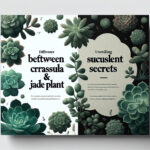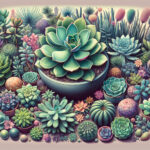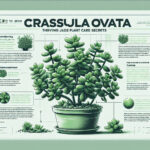Decoding the Jade Plant: Is Crassula the Real Deal?
When you step into the world of succulents, there’s a particular green celebrity that you just can’t ignore – the Jade Plant. It’s not just a plant; it’s a symbol of prosperity and resilience. But wait, before you nod in agreement, let’s stir the pot a bit. Have you ever found yourself puzzled at the garden center, wondering if the Crassula you’re eyeing is that fabled Jade Plant? Well, you’re not alone. It’s like looking at an actor in a movie and trying to place where you’ve seen him before – except, with plants, it’s a tad bit leafier and… greener?
Delving into the heart of this verdant mystery, let’s set things straight: Crassula is often mentioned in the same breath as the Jade Plant. Why? Because Crassula ovata, one of its star species, is frequently referred to as the Jade Plant. This exploration into botanical differences will help unravel the tangle of common names we so often trip over.
Think of Crassula as a diverse family of plants, a small kingdom where each member has its own quirks and charms. Among them, the Crassula ovata steps up as the quintessential Jade Plant – chunky leaves that whisper tales of wealth and a statuesque presence that demands admiration. But are all Crassulas Jade Plants? Not quite. That’s like saying every family member has the same job, which is certainly not the case in the big, wide, world of Crassula.
For instance, take the Crassula arborescens, often confused with its cousin, Crassula ovata. They both share that succulent, jade-green allure, but arborescens brings its own flair to the table with rounder leaves and a silver sheen, like the moon decided to plant a kiss on its foliage. Or imagine walking through an art gallery of succulents – each Crassula is a masterpiece, but not every piece is the famed Jade Plant we poetically place on our windowsills hoping for financial luck.
Now, let’s step into the real world for a moment. Have you ever gifted a ‘Jade Plant’ to a friend, thinking it would bring them prosperity? Chances are, it was a Crassula ovata. It’s a shared experience, part of a larger tapestry woven with plant identification and common names that often blurs the lines between species.
Diving deeper into the foliage fable, let’s bust a myth or two. You might hear whispers in the gardening community that Crassulas are demanding, diva-like plants that require the perfect environment to thrive. But, lean in close, let me tell you a little secret: they’re as easy-going as they come. Provide them with some sunshine, a little water, and watch them grow with a nonchalance that says, “I’ve got this”.
If we peek into the history books, it’s clear that the Jade Plant has been a cherished botanical companion long before our modern nurseries labeled them. Its sturdy disposition and glossy leaves have graced homes for generations, becoming an emblem of growth – both personal and as a lush, green friend. And perhaps that’s the real beauty of it. Whether you’re cradling a Crassula ovata or its kin, you’re part of a tradition that celebrates nature, simplicity, and the enduring hope for a touch of green luck in our lives.
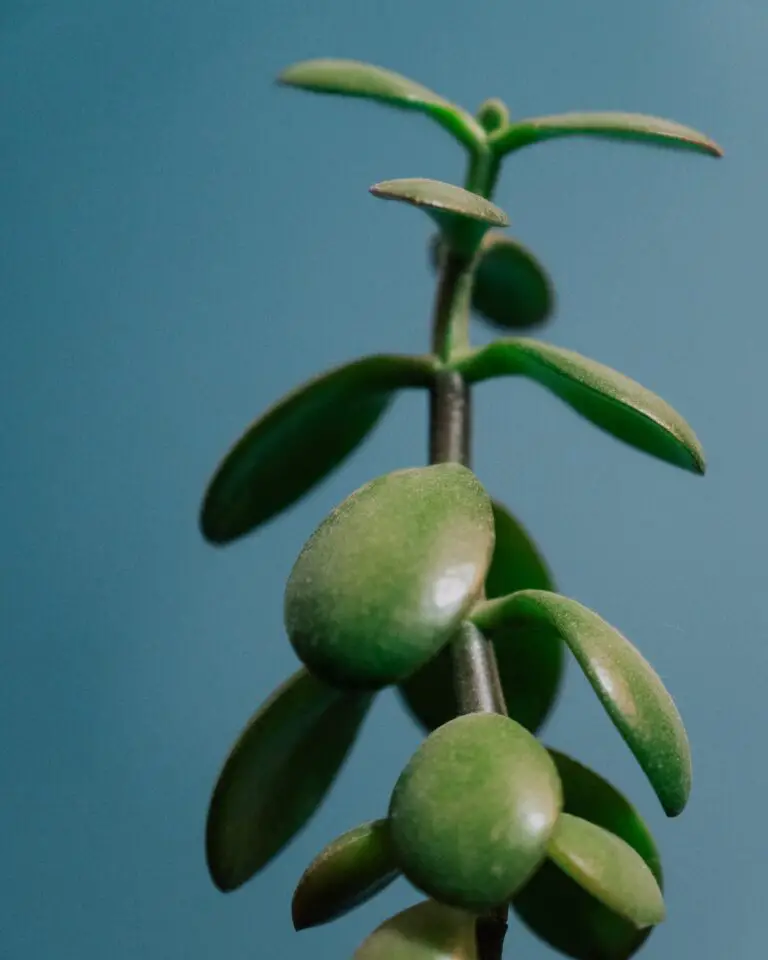
The Crassula Family: A Diverse Genus Unveiled
Step into the intriguing world of Crassula, a genus that offers a world of diversity beyond the commonly adored Jade Plant. These succulents bring more than just their plump, green leaves to the table; they carry a legacy of adaptability and resilience. But what exactly sets the Crassula family apart from their succulent relatives?
Originating from various altitudes in South Africa, Crassula species have mastered the art of thriving in different environments. From the arid deserts to rocky coastlines, these plants are true survival artists. Their distinctive characteristics, such as water-storing leaves, make them a favorite not just among seasoned botanists but also among those new to the gardening scene.
To demonstrate their rich variety, let’s consider the Crassula ovata, commonly known as the Jade Plant. It flaunts a woody stem and glossy leaves, which sometimes develop a reddish tinge when exposed to ample sunlight. Then there’s the Crassula ‘Gollum’, with tubular leaves that end in a suction-cup-like shape. It’s like stepping into a fantasy world, except it’s as real as the soil these plants root in.
The Crassula genus has an army of unique and attractive species. For an illustrative peek into their world, take a gander at this informative video:
Many Crassula species are a hot pick for indoor gardeners, thanks to their ease of care and their ability to purify air. They’re not picky about where they stand in your home, which harmonizes perfectly with the modern busy lifestyle. For enthusiasts looking to immerse themselves further in the captivating world of these succulents, reading “Cultivating Your Succulents for Vitality” could give you the know-how for gardening success!
Crassula plants aren’t just captivating; they’re a study in the art of plant diversity and adaptability. So, is Crassula the quintessential Jade Plant? Perhaps the answer lies in the beholder’s eye, or maybe, in the lush leaves of the plants themselves. The certainty, however, is that the Crassula genus stands as a proud testament to the botanical mysteries and riches our natural world holds.
Jade Plant Personified: Crassula Ovata Spotlight
Picture this: a robust, evergreen shrub with thick, glossy leaves and a propensity to thrive almost anywhere. Yes, we’re talking about Crassula ovata, the species that has become the poster child for the so-called “Jade Plant” or “Money Plant.” It’s not just its alluring beauty that makes it a favorite amongst green thumbs, but there’s a wealth of fascinating features that lift the veil on why this particular succulent is a staple in homes around the globe.
Delving into its physical attributes, Crassula ovata proudly showcases plump, oval-shaped leaves that have made it a beloved ornamental. Those chubby leaves are not just for show; they’re a reservoir for water. This clever adaptation allows our resilient friend to withstand even the most forgetful plant owners, making its care an absolute breeze—which is handily detailed in this useful guide on cultivating your own cascading jade.
When it comes to growth habits, don’t be fooled by its modest start. This slow-growing succulent can eventually morph into a stout, tree-like structure, giving a miniaturized forest feel to your living space. And let’s not forget, in good conditions, it graces us with starry white or pinkish flowers that are a joy to behold.
It’s not merely its easy-going nature and structural finesse that fuel its popularity—the Crassula ovata is draped in mystique and symbolism. Often associated with prosperity and luck, it’s no surprise it has become a customary gift in many cultures, especially during the Lunar New Year. Its tenacity to persevere and flourish with minimal fuss reflects life’s ability to thrive against the odds. If plants had personalities, this one would be the unassuming hero, quietly commanding respect and admiration.
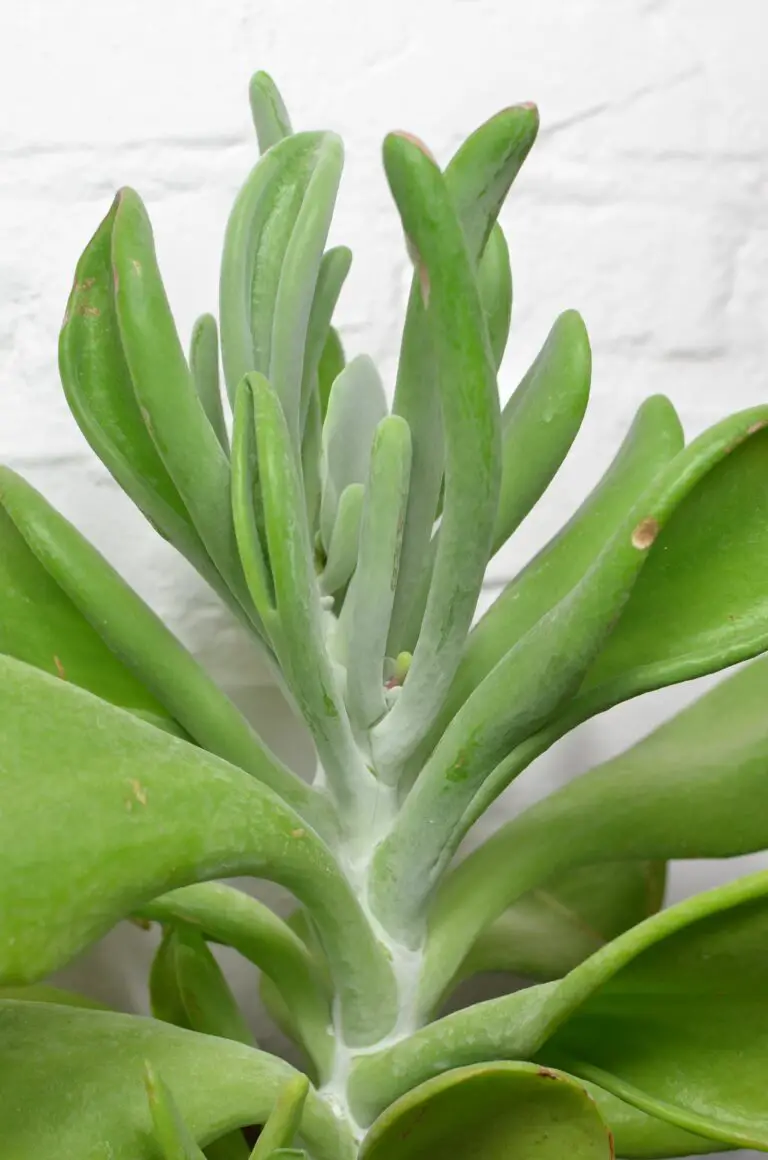
So, is Crassula ovata the quintessential jade plant? Its traits certainly suggest so. But what’s indisputable is its reign as a beloved member of the succulent family, celebrated not only for its striking aesthetic but also for its symbolism and undemanding companionship. Next time you glance at your jade plant, try to see beyond its luscious green canopy—a resilient survivor, an emblem of prosperity, and a peek into botanical wonders that continue to captivate and inspire.
Cultivating Green Wealth: Essential Care for Your Crassula Jade Plant
Imagine your home brightened by the lush, glossy leaves of the Crassula—a plant many consider the epitome of Jade plants. With its sturdy structure and resilient nature, it paints the picture of a green treasure trove in your living corner. But the question is, how do you keep this gemstone of the plant world thriving? Let’s delve into the essential care that ensures your Crassula shines bright.
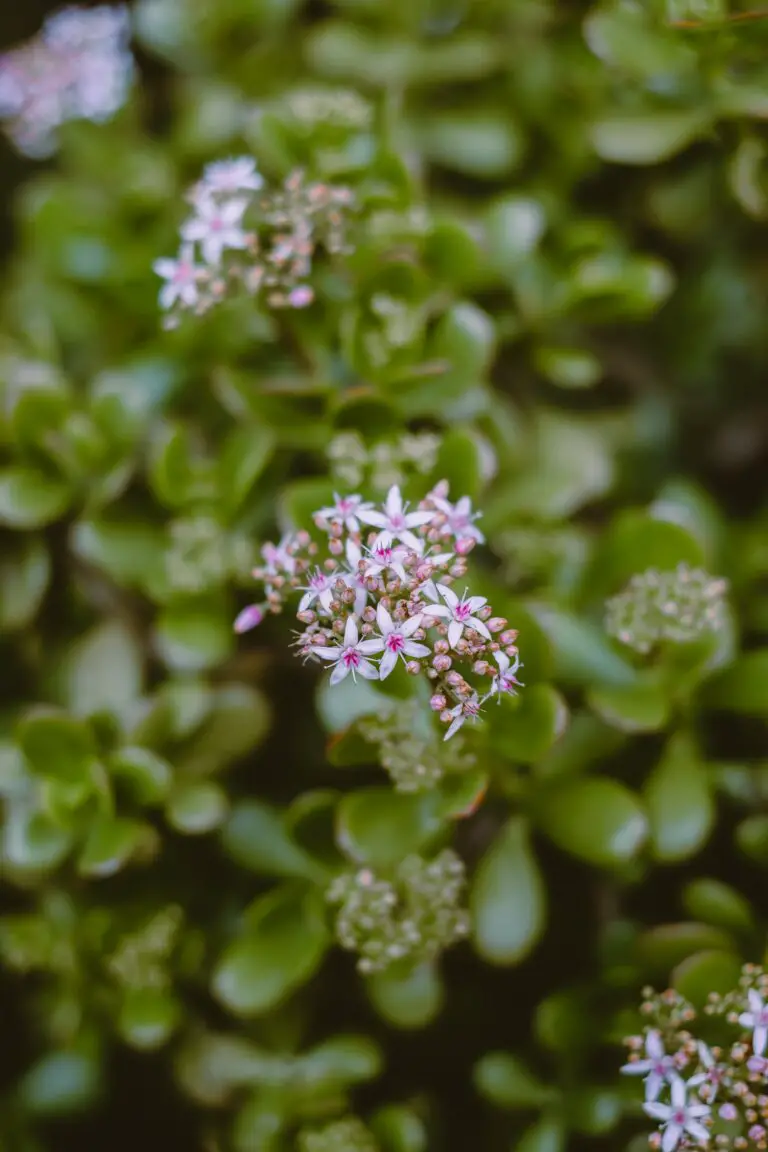
Sunlight is like the currency of life for any Jade plant. Your Crassula demands a royal seat near the sunniest window you have. A minimum of four hours of filtered sunlight is the magic number, but be wary of the midday sun’s intensity; we wouldn’t want our green wealth to go from riches to rags with scorched leaves!
When it comes to watering, timing is everything. Too much, and you risk fungal infections, too little, and your plant thirsts to a wilting point. The Crassula’s native arid environment has taught it to store water in its plump leaves, so allow the topsoil to dry between watering sessions. Picture a heavy rainfall in the desert—infrequent yet profound.
Potting Mix Perfection
Below the surface, a well-draining potting mix is crucial for your Crassula Jade Plant. Incorporate coarse sand or perlite to ensure water flows freely, avoiding soggy soil that can spell doom. Think of it as giving your plant a pair of breathable sneakers instead of a stuffy pair of rain boots.
Common Issues and Triumphs
Even with perfect care, your Crassula might face some foes. Mealybugs and scale insects are attracted to the plant’s succulent leaves like bees to nectar. Combat these pests with a simple alcohol-dipped cotton swab. And if you notice your plant’s leaves losing their Jade-like luster, a quick check of your watering logbook and the window’s sun exposure is in order.
Reflect on this: A Crassula that’s given the right balance of sunlight, water, and soil will not only survive but thrive, becoming a testament to your nurturing prowess. It’s a collaboration between you and nature to create a piece of living art that enriches your home and life. So, tend to your Crassula with these tips in mind, and watch as it flourishes into a symbol of thriving perseverance and aesthetic delight.
The Phenomenon of Jade Plant Varieties: A Display of Crassula’s Versatility
Embark on a green thumb journey into the heart of the Crassula genus, where the fleshy, vibrant foliage of jade plants captivates and enchants. Known for their plump leaves and sturdy stems, these succulents are not just a single entity; they are a tapestry of diversity, each variety offering a unique slice of splendor to your home oasis.
Let’s turn the pages of Crassula’s living library, where species such as Crassula ovata, commonly known as the ‘Classic Jade,’ sit alongside its eye-catching cousins ‘Hobbit,’ ‘Gollum,’ and ‘Harmony’s Red Robin.’ Each one of these botanical gems brings its own flair to the table – or rather, to the windowsill. From the rippled edges of the ‘Ripple Jade’ to the miniature forests crafted by the ‘Baby Jade,’ the assortment is staggering.
Recognizing the Rich Array of Jade Plants
While the Classic Jade may be the poster child of robust wellness, its relative ‘Blue Bird’ offers powder blue leaves that whisper tales of serenity. ‘Crosby’s Compact’ presents a more petite alternative, its smaller leaves packed tightly to form a lush, miniaturized bush. And let’s not forget ‘Sunset,’ whose leaves kissed by the sun’s dying light, paint a picture of golden hour in your living room. As you familiarize yourself with these cultivars, you can’t help but marvel at Crassula’s versatility in conveying different moods and aesthetics.
Crassula species don’t just vary in hue; they’re sculptural artists adept at crafting textures and forms. Some, like ‘Skinny Fingers,’ stretch upwards with elongated leaves, while others, such as ‘Hummel’s Sunset,’ prefer to spread wide, showing off leaves dipped in crimson flames. By observing their silhouettes against the light, you’ll discern subtle plays of shadow and luminescence, a dance put on by the jade plant’s architectural prowess.
Adding to their allure, Crassula varieties are not just a visual feast but also a testament to adaptation and resilience. These are plants that thrive in the tight quarters of an urban apartment just as they do basking in the sprawl of a country garden. They tolerate neglect with poise, making them perfect companions for both seasoned gardeners and aspiring green fingers. Plus, their propensity for straightforward propagation means you can easily expand your collection or share it with friends and family, spreading the joy of gardening.
Whether you’re drawn to the understated elegance of the ‘Silver Dollar Jade’ or the striking contrast of the ‘Variegated Jade,’ incorporating these plants into your living space means inviting a piece of nature’s adaptable art into your daily life. Explore the Crassula genus, watch the varieties flourish under your care, and witness the effortless charm of the jade plant in all its glory.
Indoor Oasis: Crafting the Perfect Environment for Your Jade Plant
Imagine stepping into a room where the air feels fresher, the space more vibrant, and your mood instantly uplifted. This is the transformative power of the Crassula, commonly known as the jade plant. As a succulent, it’s not just an ornament; it’s a living sculpture that animates any interior. But the question is, how do you integrate such a gem into your home or office space to reap all its aesthetic and therapeutic benefits? Let’s dive into some insights that turn your living spaces into an indoor oasis with the quintessential jade plant.
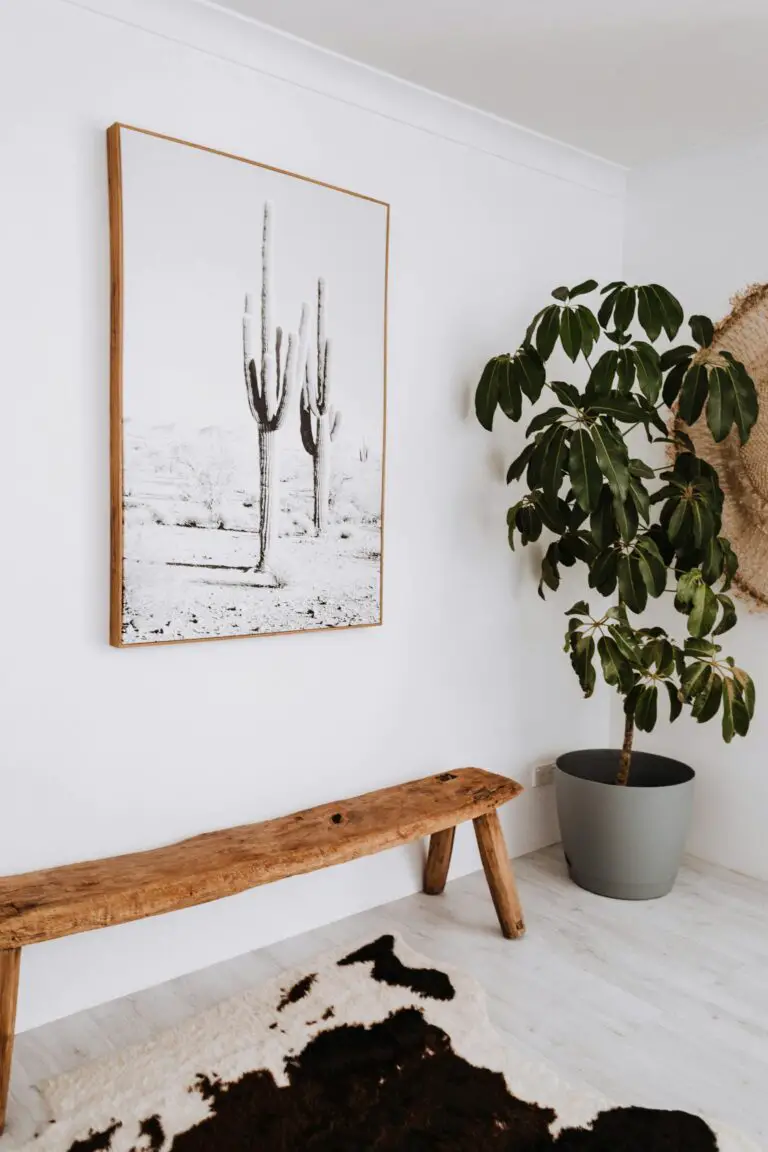
The perfect placement of a Crassula jade plant can be compared to finding the ideal spot for a piece of art. It requires thoughtfulness and creativity. Eastern or southern windows that bathe in the soft morning sun provide the perfect lighting backdrop for your plant. As the sun pirouettes through the leaves, it creates a dynamic shadow play that can illuminate and add depth to any corner of the room. If your space lacks such windows, fret not. With grow lights mimicking the sun’s warmth, your Crassula will thrive and continue to add its lush green beauty to your space.
But why stop at just one? A jade plant can be the anchor of a verdant vignette when paired with companion plants. Imagine a Crassula as the centerpiece, flanked by a group of Haworthias or Echeverias, creating a tapestry of succulent varieties that can spark a conversation or inspire tranquility in a workspace. Select companions that not only complement the Crassula’s lusciousness but also share similar light and water needs, ensuring they grow harmoniously together.
Furthermore, incorporating a jade plant into your interior isn’t just for the green-thumbed enthusiast—it’s a choice that speaks to a refined aesthetic. A single, mature Crassula can serve as a sophisticated focal point in a minimalist setting, while a cluster of jade plants can infuse life into a bohemian-styled room, proving that these succulents are incredibly versatile decor elements.
From the sleek boardrooms to the cozy nooks of our homes, the Crassula Jade Plant carries with it an air of elegance and simplicity. Imagine it on a bookshelf amidst a collection of classic literature, or on a coffee table accompanying your morning routine. It’s these subtle integrations that make the Crassula not just a houseplant, but a cherished part of your daily living space, enhancing your environment one leaf at a time.
Troubleshooting Your Crassula: Dealing with Pests, Diseases, and Other Setbacks
If you’re reading this, chances are you’re facing some hiccups in your Crassula cultivation journey. Fear not, fellow plant enthusiast. Let’s dive into the nitty-gritty of common Crassula problems and serve them an eviction notice!
Are Your Crassulas Not Feeling Quite…Crass-y Enough?
Joking aside, mood swings in your Crassula could be a sign of pest or disease infestation—perhaps it’s a sneak attack from mealybugs, or your Jade Plant has turned into a spider mite motel. Maybe the leaves look like fungal gnats threw a party and forgot to clean up. Spotting the culprits early could be the difference between a minor setback and a plant apocalypse!
`Houseguests` and How to Politely Show Them Out
Let’s start with uninvited houseguests: pests. Mealybugs are like the relatives who overstay their welcome. They’re notorious for setting up camp in the nooks and crannies of Crassula leaves. These cottony guests suck the life out of your plant—quite literally. Before you unleash your fury, remember, the key is to be both gentle with your plant and ruthless with the bugs. A cotton swab dipped in alcohol can be your weapon of choice for small invasions.
Spider mites, on the other hand, are stealthier. They’re tiny, but the damage they cause is not. Thin webbing is a dead giveaway. If you spot these, blast them away with a spray of water or introduce natural predators such as ladybugs into the mix—if your indoor ecosystem allows it, of course.
What about fungus gnats, you ask? They love moisture a bit too much. Overwatering is an open invitation for these pests. The fix? Let the soil dry out between waterings, and consider adopting gnats’ natural enemy – the carnivorous plant! Now, that’s a plot twist that would make Mother Nature proud.
Now, allow me to share a visual guide that makes tackling these issues a breeze. An ounce of prevention is worth a pound of cure, so take a peek at this super helpful video!
${‘‘}
Plants Get Sick Too: Crassula Diseases Unveiled
On to diseases: crassula plants are resilient, yet they’re not immune to issues like root rot or powdery mildew. Ensuring proper drainage can prevent the dreaded soggy-bottom scenario that leads to root rot. Think of it like this – Crassulas are like cats. They hate wet feet! As for powdery mildew, keep the air moving. A little breeze can do wonders to keep this fungal foe at bay.
Regardless of the challenge, remember that your Crassula is more than just a plant—it’s a living testament to your care and dedication. With the right approach, you’ll be back to admiring its plump, jade-colored leaves in no time. Roll up your sleeves, it’s time to show these pests and diseases the door!
FAQs: Your Questions About Crassula Jade Plants Answered
If you’ve ever found yourself gazing at a picturesque Crassula and pondering, “is this the epitome of a jade plant?”—you’re not alone. These succulent beauties often stir up a mix of admiration and botanical bewilderment. Let’s dive into the world of Crassula, the plant that may just be the quintessential representation of jade plants as we know it.
What Makes Crassula a ‘Jade Plant’?
When people refer to ‘Jade Plants’, they’re usually envisioning Crassula ovata, the common jade plant. But the genus Crassula is broad, including a variety of species that share that lustrous, green jade-like appearance. Crassula plants are hardy, easy to care for, and have that classic, glossy succulence that’s become synonymous with good luck and prosperity in many cultures.
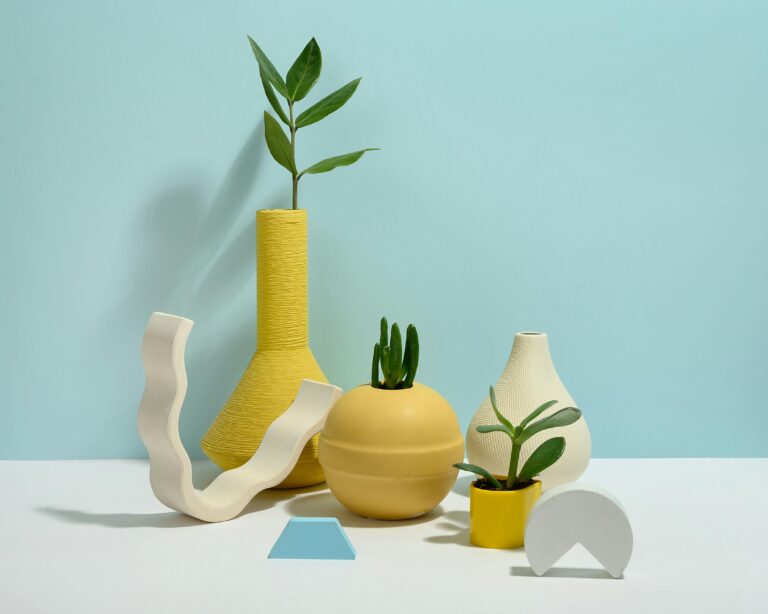
How Do You Identify a Crassula?
Identification is all about noticing the details. Crassula plants typically possess thick, fleshy leaves that retain water, an adaptation that’s a hallmark of succulents. They are diverse in form, too—from the tree-like structure of Crassula ovata to the compact, braided appearance of Crassula muscosa. If you’re unsure if your succulent is a Crassula, check for rounded, glossy leaves or consult with a local nursery expert.
Can Crassula Plants Flourish Indoors?
Absolutely! Crassula plants thrive indoors with the right conditions. They prefer bright, indirect sunlight and minimal watering—making them ideal for that sunny spot in your living room. Their resilience also means they’re forgiving to those new to plant parenthood. Imagine a Crassula sitting on your window sill, subtly reminding you of the beauty and simplicity of nature amidst your busy urban life.
What’s the Most Unusual Variety of Crassula?
Among the myriad of Crassula species, some stand out for their unique traits. Take the Crassula umbella ‘Wine Cup’ for instance—characterized by its cup-shaped leaves that seem to toast to the sky. Or the Crassula ‘Buddha’s Temple’, which forms a mesmerizing mini-tower of tightly stacked leaves. Each variety has its own character, much like the distinctive personalities you’d encounter at a vibrant garden party.
Are Crassula Plants Pet-Friendly?
For those who share their home with fur companions, it’s crucial to know that not all Crassula species are pet-friendly. While Crassula ovata is generally safe, it’s wise to do your homework for each species, as some may be toxic if ingested. Picture your cat curiously sniffing around your Crassula—good pet ownership means ensuring both plant and pet can coexist safely.
How Do Crassula Plants Contribute to a Healthy Home Environment?
Keeping a Crassula plant is more than just about aesthetics; it’s about creating a healthy home atmosphere. These plants are known to purify the air, remove toxins, and increase humidity. Plus, caring for a plant can be incredibly therapeutic—nurturing a Crassula might become your go-to stress reliever after a long day at work.
Throughout this deep dive into the Crassula jade plant’s wonders, we’ve touched on the hows and whys that make these succulents special. Each question peeled back a layer, revealing stories of resilience, adaptability, and tranquil beauty. The Crassula, with its understated elegance, truly embodies the spirit of the jade plant—a testament to nature’s marvelous and mysterious ways.
